
Hiking Around Las Vegas, Grand Canyon National Park

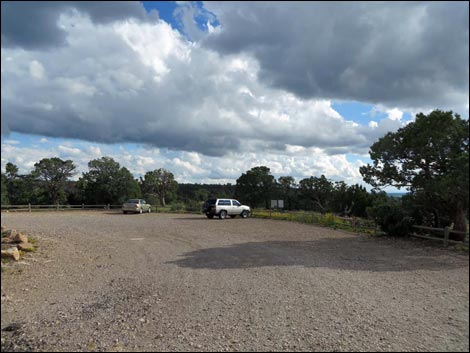 Hermit trailhead parking (view SW) |
Overview This great trail runs steep and rocky from Hermits Rest (about 6,640 ft elevation) on the rim to Hermit Rapids on the river (about 2,350 ft elevation. Water is available at Santa Maria Spring, Hermit Creek, and the Colorado River. The trail has a fair bit of history, and remains (e.g., foundations and rock walls) of the Santa Fe Railroad tourist camp can be seen at the junction of the Tonto and Hermit Rapids trails. The first section of trail switchbacks down quickly from the rim to the Supai Formation in the back of Hermit Canyon. The trail then turns to run north at a fairly level grade above the Redwall, passing the stone resthouse at Santa Maria Spring. At an overlook with a great view of the inner canyon, the trail drops quickly through a gap in the Redwall, the Cathedral Stairs. Link to map. |
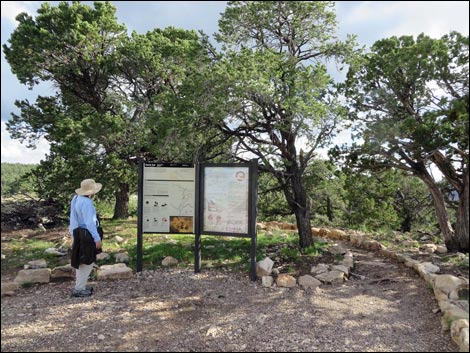 Hermit trailhead information sign (view SW) |
Below the Redwall, the trail descends at a moderate grade onto the Tonto Platform and meets the Tonto Trail. On the Tonto Platform, the Hermit Trail runs concurrently with the Tonto Trail as both head southwest into the back of Hermit Canyon. About a mile beyond the junction, the old Santa Fe Railroad tourist camp marks the junction where the Hermit Creek Trail drops into Hermit Canyon and runs north to the Colorado River. Hermit Creek campground is about 0.25 miles farther back into Hermit Canyon on the Tonto Trail; there are campsites along the river too. |
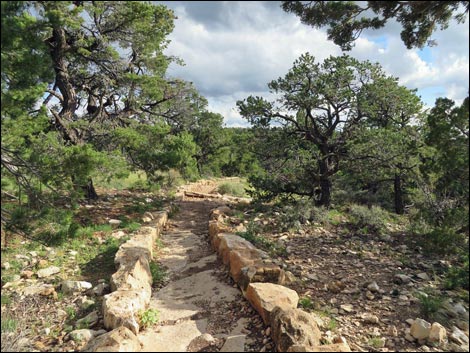 Start of the Hermit Trail (view S) |
Watch Out Other than the standard warnings about hiking in the desert, ...this is a steep and rocky trail. There are many places where the trail is steep, narrow, and rocky, and where a fall would be fatal. The Park Service no longer maintains this trail, but it still is good and easy to follow. During summer, the cool temperatures on the rim give way quickly to scorching temperatures lower in the canyon. While hiking, please respect the land and the other people out there, and please try to Leave No Trace of your passage. This is a long hike, so be sure to bring the 10 Essentials, and be sure that this route is of the appropriate difficulty for your hiking skills. |
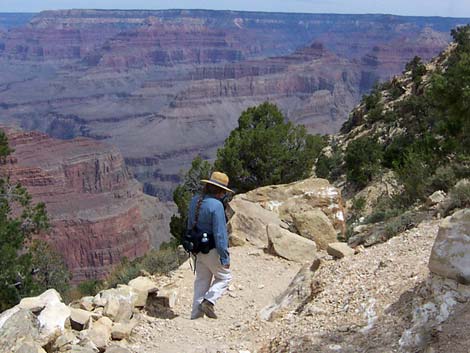 |
Getting to the Trailhead This hike is located on the South Rim of the Grand Canyon, about 5 hours southeast of Las Vegas. From Las Vegas, drive out to the South Rim of Grand Canyon National Park. From the South Rim Visitor Center (Table 1, Site 0811), ride the shuttle bus or drive to the Hermits Rest trailhead (Site 0815), which is west of the South Rim Village area. The trailhead is just west (past) of the Hermits Rest buildings on the Hermit Road. When the shuttle bus is running (spring through fall), take it to Hermits Rest. Walk past the tourist facilities and past the housing area to the end of the road. Either walk past the restrooms and down the gravel road, or walk past the Hermits Rest building and out the trail along the rim. It is about 0.25 miles from the bus stop to the trailhead. When the shuttle is not running, drive to the trailhead or arrange for a taxi. |
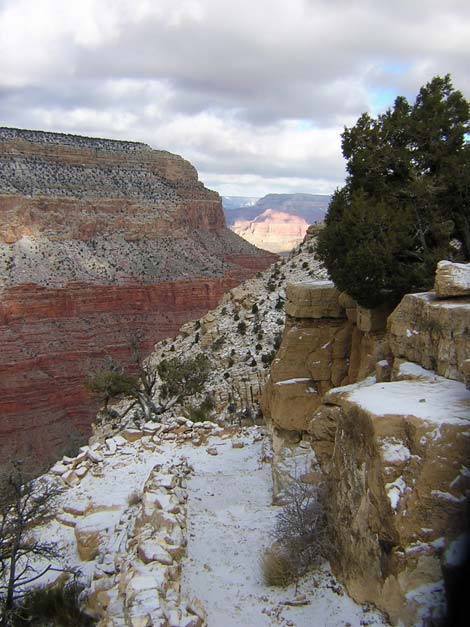 Switchbacks through upper rock layers (view NW) |
The Hike From the trailhead (Table 2, Waypoint 01), the trail switchbacks quickly down through the Kaibab Limestone. This part of the trail is steep and rocky, but there are lots of fossils (e.g., brachiopods, corals, and sponges) and some wonderful views along the trail. The vegetation is pinyon-juniper forest, so there is a fair bit of shade along the trail. Below the Kaibab Limestone, the trail passes the Toroweap Formation and comes to the Coconino Sandstone. There are some nice sandstone walls here, but the trail passes through a broken down and slabby section. In the lower part of the Coconino Sandstone, about an hour (1.1 miles) below the trailhead and just above the bottom of the canyon, there are some interesting fossilized reptile tracks in the sandstone slabs adjacent to the trail (Wpt. 02). There are several kinds of tracks here. The fossils are on a long, straight section of trail that is "paved" with sandstone cobbles. Please don't climb the slabs or walk on the fossils because you will cause them to erode more quickly. The best fossils are adjacent to the trail, so you don't need to leave the trail to see the best tracks. Just below the fossil tracks, the trail drops into the Hermit Shale at Waldron Basin, a fairly broad, open, and well-vegetated basin in the bottom of Hermit Canyon. The trail hits the bottom of the canyon, then turn north and runs downhill along the wash. After hiking through the cliffs, this area feels quite forested, as there are lots of pinyon pines, juniper, and other vegetation. About 10 minutes below the fossil tracks, the Waldron Trail forks off to the south (right) and heads up the canyon. That trail leads to the rim at a point west of Hermits Rest; this is another way to start the hike into Hermit Canyon. |
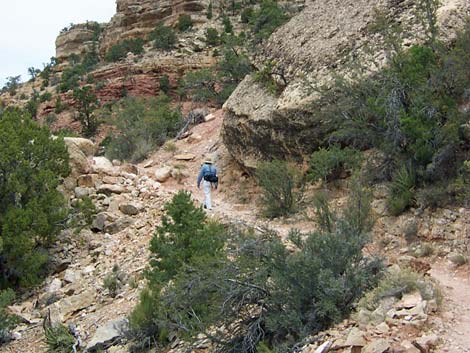 Looking back: some parts of the trail are steep (view SE) |
About ten minutes and 0.25 miles beyond the Waldron Trail junction, near the bottom of Waldron Basin, the trail leading to Dripping Springs and Boucher Creek forks off to the southwest and climbs the hillside (Wpt 03; 1.4 miles). The Hermit Trail continues down the bottom of the canyon and quickly arrives at a pour-over with a great view down Hermit Canyon. The trail runs down a few switchbacks through a cleft in the cliff, and then continues running north along the east side of Hermit Canyon. About 0.5 miles and 20 minutes below the Dripping Spring-Boucher trail junction, and after running at a fairly level grade across the steep hillside, the trail arrives at Santa Maria Spring (Wpt. 04). There is a stone resthouse at the spring with benches, shade, and a great view across the canyon. There is a restroom below and just up-canyon from the resthouse (walk beyond the resthouse to find the trail down to the restroom). Spring water comes out of a pipe in the hillside and flows into a trough. The water from the pipe probably is safe to drink raw, but the Park Service suggests filtering or treating it. |
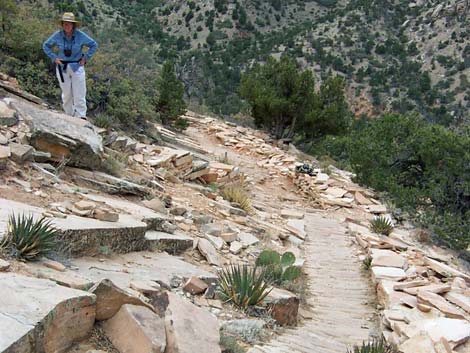 Hiker at the fossil reptile tracks (view SW) |
Beyond Santa Maria Spring, the trail runs along the Supai Formation for about 3.3 miles, staying atop the Redwall. The trail is never level, but it generally runs up and down at moderate grades as it winds in and out of side canyons. There are a few places where the trail crosses small rockslides and where the trail cuts steeply down through the cliffs on rockslides. The slide areas pose no serious problems, but occasionally you have to stop for a moment to figure out where to go. All of this section runs on a steep hillside that makes for grand views, but it also comes with tripping hazards and potentially fatal results. By this time, the trees and tall shrubs generally are above you, so they don't obstruct the view, but they don't provide shade either. |
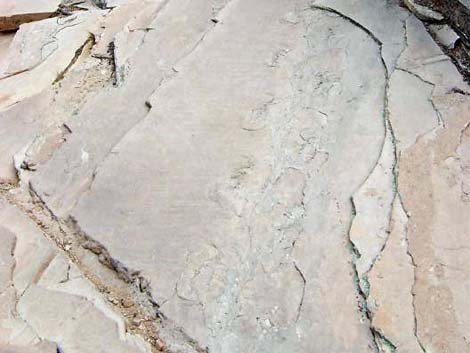 fossil reptile tracks (view S) |
About 40 minutes or so beyond Santa Maria Spring, the trail passes Lookout Point, a rock buttress that juts out into the canyon. The summit knob is only a minute off the trail and provides great views up and down the canyon. About 45 minutes beyond Lookout Point, the trail passes Breezy Point, another spot with nice views into the canyon. About 10 minutes beyond Breezy Point, the trail arrives at the Cathedral Stairs, a steep, rocky break in the Redwall (Wpt. 05). The Cathedral Stairs is a steep set of many short switchbacks with spectacular views down the hillside and out into the canyon. The trail through the Redwall is good, but there are many loose rocks and other tripping hazards, and extra care should be taken, as you will be getting tired by the time you get here. It takes about 20 minutes to descend through the Redwall here. |
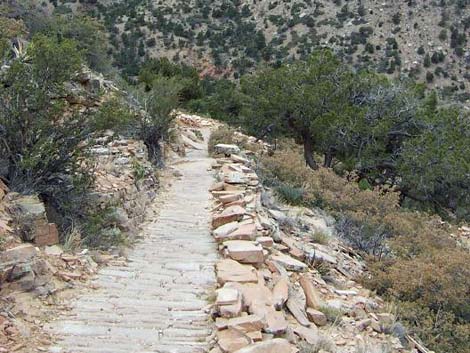 Trail continues towards Waldron Basin (view SW) |
Below the Cathedral Stairs, the trail runs fairly straight and steeply across the west side of Cope Butte. The trail runs down to a final set of switchbacks that drop you onto the Tonto Platform and the Tonto Trail (Wpt. 06). From the bottom of the Redwall, it takes about 20 minutes to get to the Tonto Trail junction. From the trail junction, the wide and rocky Tonto Trail turns southwest and heads downhill at a fair grade that feels level compared to where you have been. After about 20 minutes (about 1.0 miles), you arrive in the Santa Fe Railroad tourist camp area. Some stonewalls and foundations of the tourist camp remain, and the old corral on the south side still seems to be used. It is interesting that you can still tell by differences in the vegetation where things used to be, even though some vegetation has grown back over the years. Just below the tourist camp, the Hermit Rapids trail forks off to the northwest and runs down a side canyon into the bottom of Hermit Canyon. |
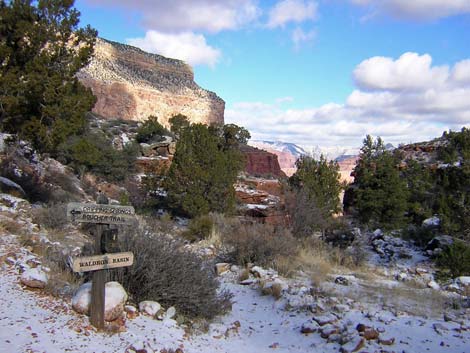 Waldron Basin at Hermit-Boucher junction (view NW) |
Continuing farther back into the canyon (south) on the Tonto Trail for another 10 minutes and 0.3 miles brings you to the Hermit Creek camping area, which is spread out along the east side of Hermit Creek (Wpt. 07). The last 3-4 minutes of trail cuts steeply down through a band of cliffs into the camp area. The outhouse is located right where the trail drops below the cliffs. From the Hermit Creek Trail junction, it is about 1.5 miles to the Colorado River. I didn't hike to Hermit Rapids, so I can't say anything specific, but the trail gets a lot of use, and the upper parts look easy. From the junction, the trail drops through a cleft in the cliffs on a trail that looks like it was built by the same stoneworkers who build the walls at the tourist camp. The trail drops into the bottom of the canyon and runs down along the creek. The canyon is deep and narrow, so you can't see much of it from the Tonto trail. Hermit Rapids was formed by boulders and other debris that flowed down Hermit Canyon, and there is a sandy beach with campsites (Wpt. 08). To return to the trailhead, retrace your footprints or consider hiking out on one of the loops (Boucher Trail or Tonto to Bright Angel), or just up the Dripping Spring Trail from Waldron Basin to the rim. |
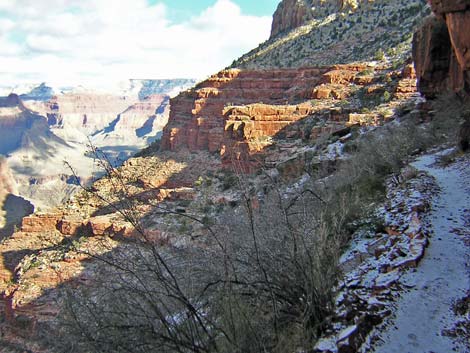 Steep hillsides in the cliffs (view NE) |
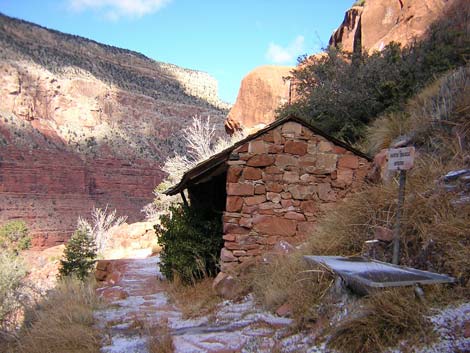 Santa Maria Spring and rest house (view N) |
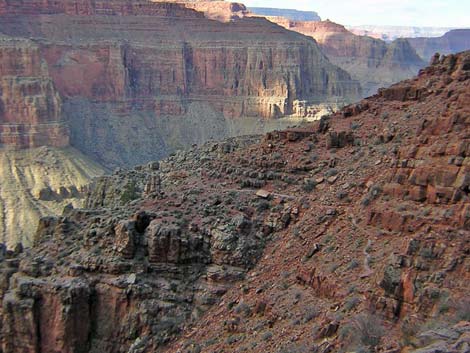 Trail on hillside above the Redwall (view northwest from trail) |
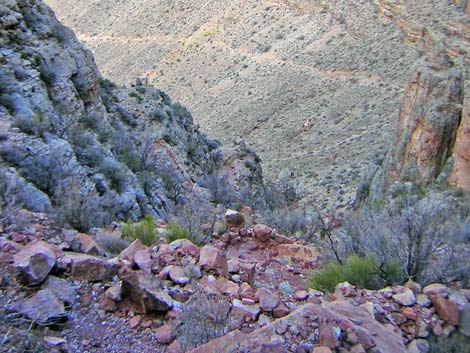 Top of the Cathedral Stairs (view N) |
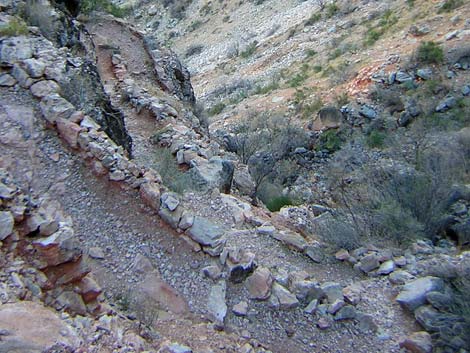 Cathedral Stairs and the trail below Cope Butte (view N) |
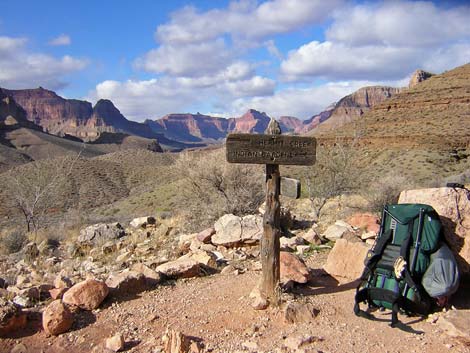 Hermit-Tonto trail junction (view W) |
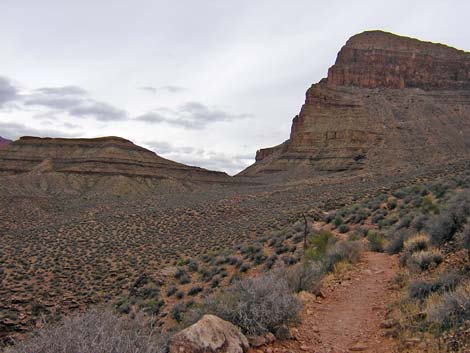 Looking Back: Tonto Trail west of Hermit-Tonto junction (view E) |
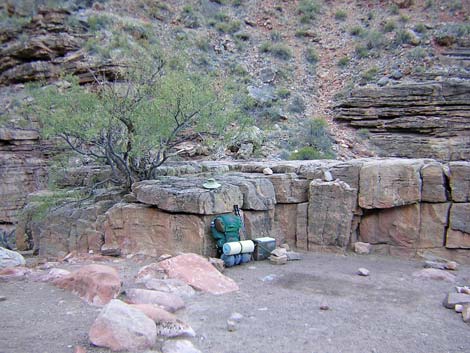 Hermit campsite |
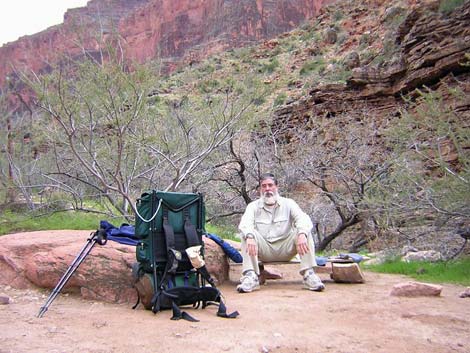 Hermit campsite |
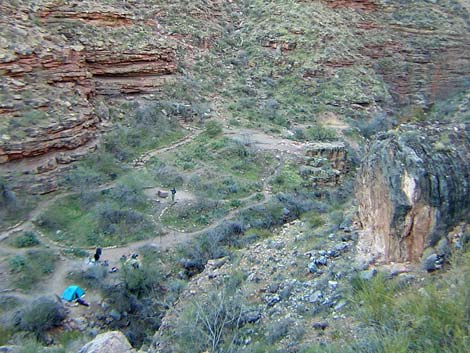 Hermit Camp (view SE from Tonto Trail W of camp) |
Table 1. Highway Coordinates (NAD27, UTM Zone 12S). NOTE: This is UTM Zone 12. Download Highway GPS Waypoints (*.gpx) file.
| Site # | Location | Latitude (°N) | Longitude (°W) | UTM Easting | UTM Northing | Elevation (feet) | Verified |
|---|---|---|---|---|---|---|---|
| 811 | Visitor Center, Canyon View Information Plaza | 36.05897 | 112.10848 | 400166 | 3990857 | 7,092 | Yes |
| 815 | Hermits Rest trailhead | 36.06044 | 112.21170 | 390870 | 3991131 | 6,642 | Yes |
Table 2. Hiking Waypoints (NAD27, UTM Zone 12S). Note: This is UTM Zone 12S. Download Hiking GPS Waypoints (*.gpx) file.
| Wpt. | Location | Easting | Northing | Elevation (ft) | Point-to-Point Distance (mi) | Cumulative Distance (mi) |
|---|---|---|---|---|---|---|
| 01 | Hermits Rest | 390897 | 3991147 | 6,640 | 0.0 | 0.0 |
| 02 | Fossil Tracks | 390125 | 3990535 | 5,600 | 1.1 | 1.1 |
| 03 | Hermit-Boucher Junction | 389797 | 3990599 | 5,240 | 0.3 | 1.4 |
| 04 | Santa Maria Spring | 390019 | 3991109 | 5,000 | 0.5 | 1.9 |
| 05 | Cathedral Stairs | 392103 | 3993543 | 4,420 | 3.0 | 4.9 |
| 06 | Hermit-Tonto Junction | 391671 | 3994131 | 3,223 | 0.9 | 5.8 |
| 07 | Hermit Creek | 390849 | 3993469 | 2,875 | 1.2 | 7.0 |
| 08 | Colorado River | 391178 | 3995515 | 2,350 | 1.5 | 8.2 |
Happy Hiking! All distances, elevations, and other facts are approximate.
![]() ; Last updated 240326
; Last updated 240326
| Hiking the Grand Canyon | Hiking Around Las Vegas | Glossary | Copyright, Conditions, Disclaimer | Home |